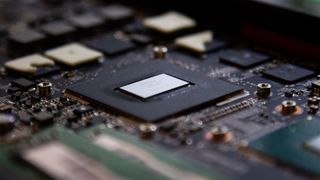Falling GDDR6 demand might keep AMD and Nvidia graphics card prices in check after all
Increase here, decrease there, net neutral

The price of graphics cards has been hard to watch recently, but there's some hope that they may be stabilizing. One of the core components of a graphics card, its memory, is seeing reduced demand and lowering prices, according to TrendForce, and that could play a part in keeping prices from rising this year.
The recent crackdowns on cryptomining and the fall of crypto currency values may be playing a big part in the sinking demand for graphics cards and, in turn, graphics DRAM. With prices of DRAM lowering in response, the prices of products that rely on these memory modules can drop correspondingly — or, at least, not get any higher.
- AMD vs Nvidia: who makes the best graphics card?
- GPU availability has a bright side, though not perfectly bright
- Nvidia’s RTX 4000 GPUs: all you need to know
There's more to it than DRAM
Graphics cards from Nvidia and AMD have taken us all on a wild ride over the past year as inventory has been hard to find and MSRP has felt like a laughable notion when confronted with the actual prices available from resellers. Anything that can bring those prices back toward MSRP is welcome by consumers and PC enthusiasts.
Graphics DRAM like GDDR6 is a necessary component in the latest graphics cards from AMD and Nvidia. The high-end cards also tend to use more of it. It's also used heavily in the Xbox Series X and PlayStation 5. So, falling graphics DRAM prices should help bring those prices back down.
Unfortunately, DRAM isn't the only component of graphics cards at issue. There's also the silicon — the GPU at the heart of the card itself. A recent announcement from Samsung has raised concerns that Nvidia graphics cards will see increased prices as they rely on Samsung's chip fabrication for their GPUs. Similarly, TSMC will be ending bulk discounts for large customers, and AMD is just such a customer.
The net result could be that the falling DRAM prices and rising chip fabrication prices will balance out in some way, but it's impossible to predict just how everything will pan out.
Via WCCFTech
Get daily insight, inspiration and deals in your inbox
Get the hottest deals available in your inbox plus news, reviews, opinion, analysis and more from the TechRadar team.
Over the last several years, Mark has been tasked as a writer, an editor, and a manager, interacting with published content from all angles. He is intimately familiar with the editorial process from the inception of an article idea, through the iterative process, past publishing, and down the road into performance analysis.

